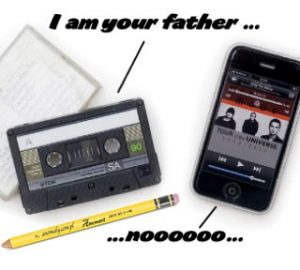The two terms a digital native and a digital immigrant were coined and defined by Marc Prensky in his article Digital Natives, Digital Immigrants.
A digital native is a person who has been exposed to new technologies since early childhood. He or she is surrounded by laptops, tablets and a bunch of other smart devices. He or she often interact and perceive the world through video games and social networks. A digital immigrant is a person who has learnt how to use technologies later in their life.
Whether you are a digital native or immigrant, it can be easily determined by a simple test.
Take a look at the image below. If you can tell what the pencil is used for, you are definitely a digital immigrant, just like me.

The most commonly used examples of an analogue accent are printing out an email or a document that needs to be edited instead of reading and writing on a computer. Prensky’s favorite example is the did-you-get-my-email phone call.
The enormous gap between the two languages and ways of thinking is best illustrated by YouTube videos of babies trying to browse paper magazines or how kids react to old-fashioned computers and rotary phones.
It goes even far beyond than we suspect or realize. Dr. Bruce D. Perry of Baylor College of Medicine claims that different kinds of experiences lead to different brain structures.
The problem, however, is much greater than we imagine. This difference does not only affect our communication but also two major areas of our lives – namely, education and work.
Education
The current education system complains that young people do not want to study and they are illiterate. Actually, it is the other way around: some digital immigrants are illiterate with respect to the fast-changing world around us.
Mitch Robinson explains in his article Why Being A Student Entrepreneur Is So Frustrating how a digital native feels in present educational institutions. Digital natives are disengaged and think that they learn less than they would if they were in another environment. They graduate only because the society requires it.
Consequently, there is a great waste of time and resources in educational institutions.
We try to educate digital natives using stone-age instruction methods. We want them to learn obsolete information and facts in a language they do not understand. We want to teach them one thing at a time and impose a slow pace when their most striking abilities are to multitasking and processing of information at a fast pace.
We should capture digital generations’ attention and interest at school.
We should also develop their critical thinking and problem-solving skills.
Furthermore, we should shift the focus from skills we think they need to those that will be more useful in the digital era.
Some schools of the new type have already appeared. Ørestad Gymnasium in Copenhagen, for example, avoids traditional instruction by encouraging students to collaborate in open settings and enhancing flexible thinking. Blue School in New York focuses on compassion and creativity. Students there create 3D models and fix home appliances.
These schools are small islands of new awareness in the big ocean.
An innovative learning model should be adopted on a larger scale.
The existing education system is overloaded and a massive short circuit is inevitable. It cannot capture the interest of the younger generations who feel disengaged and unconcerned at school. A digital native is instructed by analogues methods. This adversely affects the quality of their education.
Therefore, the system needs a major reboot.
We should take more drastic measures to change the status quo. That is why the goal of our project Classroom as a Playground is to change the present teaching methodology and tailor it to the needs of digital generations. It involves transforming the learning environment as well as the one-dimensional teaching materials used at present.
The above problem becomes even more pressing when digital natives enter the workforce.
Employment
Many large companies nowadays experience difficulties when they hire digital natives since they do not fit into the organizational structure, work processes and company cultures.
They have their own way of thinking and doing things. Moreover, they are not used to doing repetitive activities, especially when they can be automated. They use different communication patterns and channels.
As I already pointed out in my previous article Enthusiasm in the Workplace: Is it Possible?, approximately 90% of the world population is not engaged at work, according to a Gallup’s research. The main reason therefore is routine and boredom. Moreover, the repercussions are far greater than just having employees quit. They may lead to a dramatic decrease of productivity, errors, incidents and complete lack of creativity.
Our solution is to change the way work is perceived and done.
The first step in our project Workplace as a Playground is to change the work environment and make the office a fun place to be in.
Our second step is to introduce gamification not only in training but also in daily work activities. We will also focus on employees’ interests and hobbies and try to discover their hidden talents and abilities.
Then we will fuse them into their work.
Thus we will gradually make the workplace more interesting and exciting and bring back passion and enthusiasm. How we imagine our workplace as a playground is best illustrated in our Imagine a world… SERIES. Do not be misled by the title (it is a web prose, not a video clip. You cannot watch it; you have to read it).
For more learning tips, check our entrepreneurship section section and subscribe to our weekly newsletters.